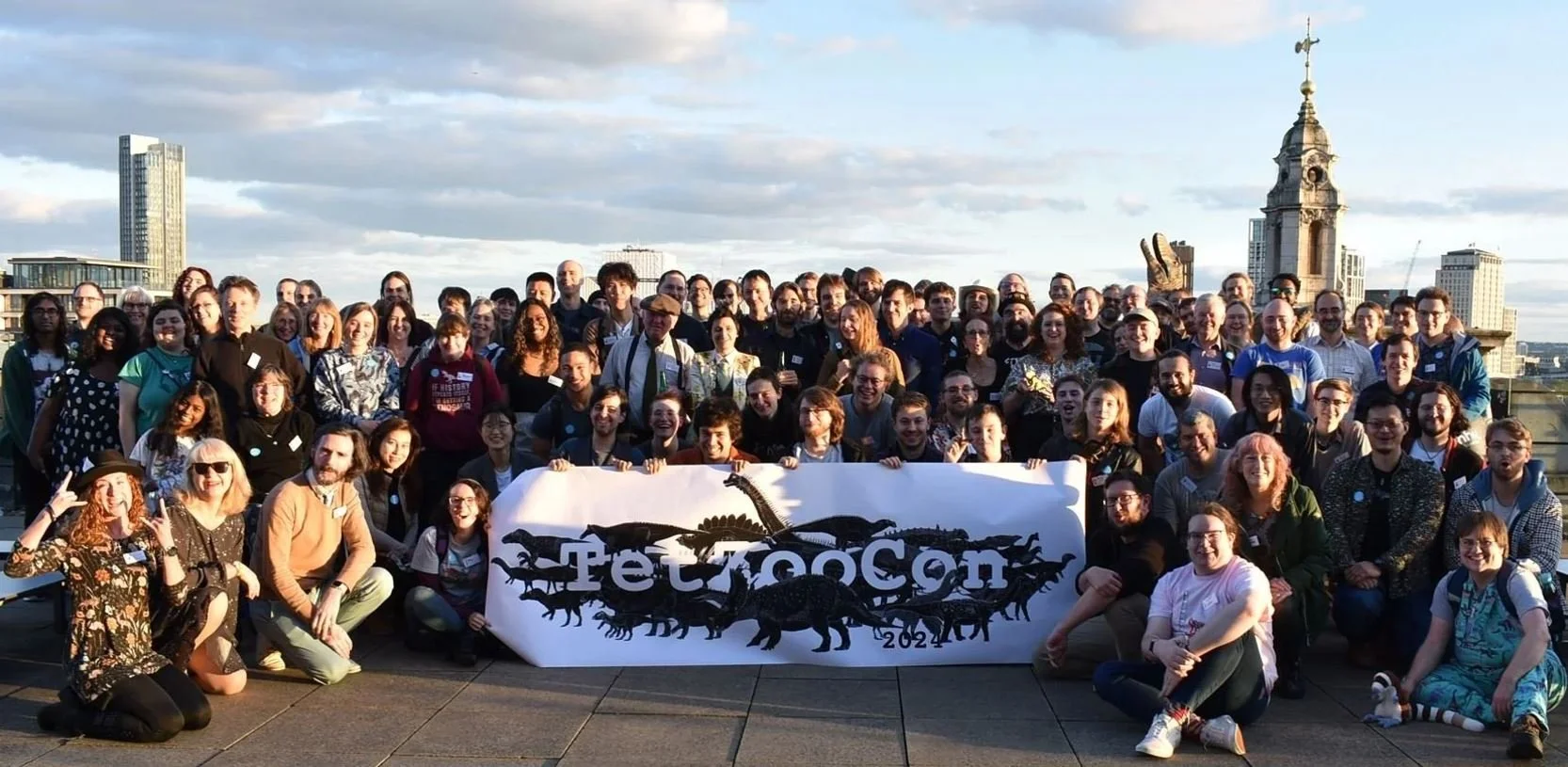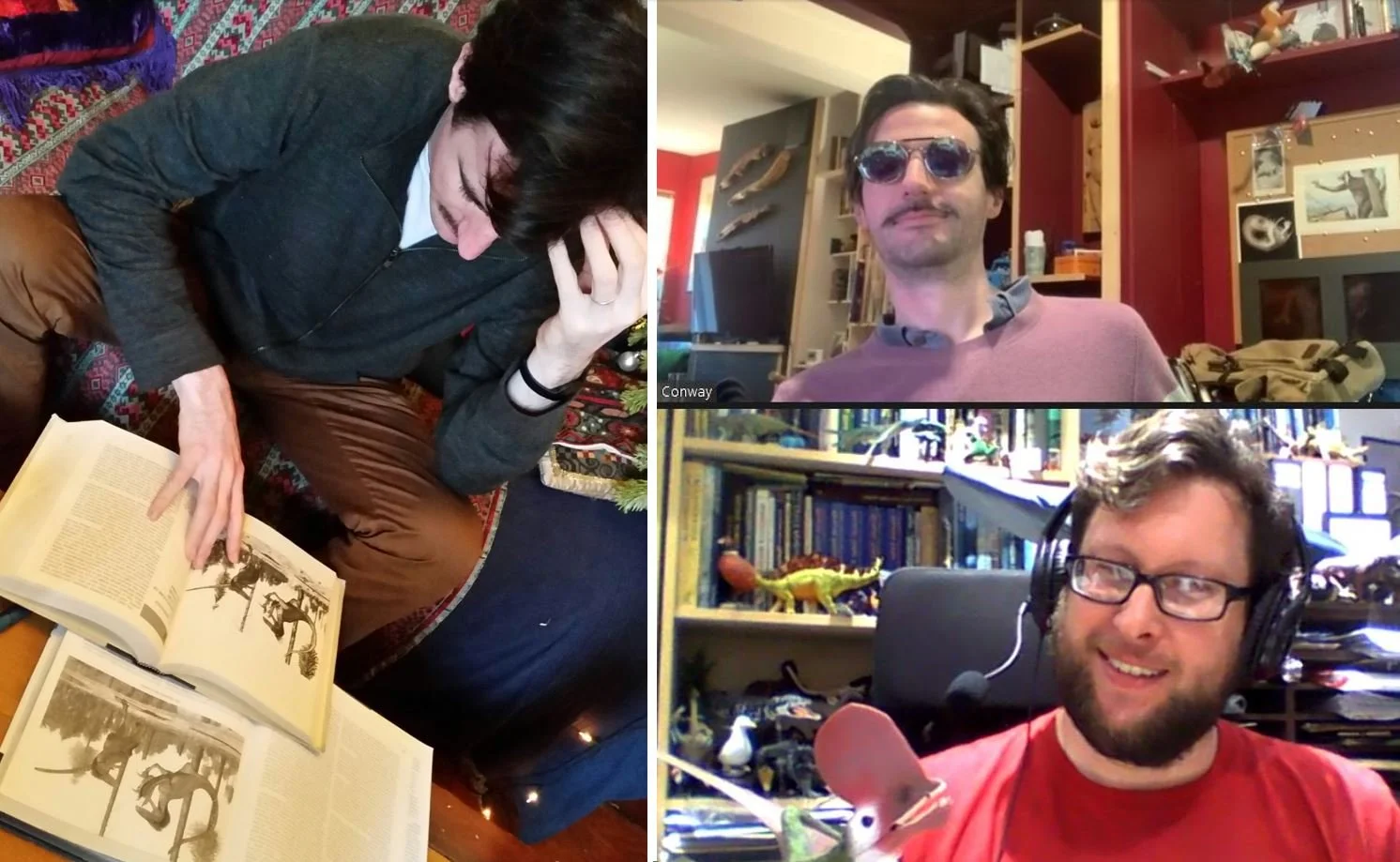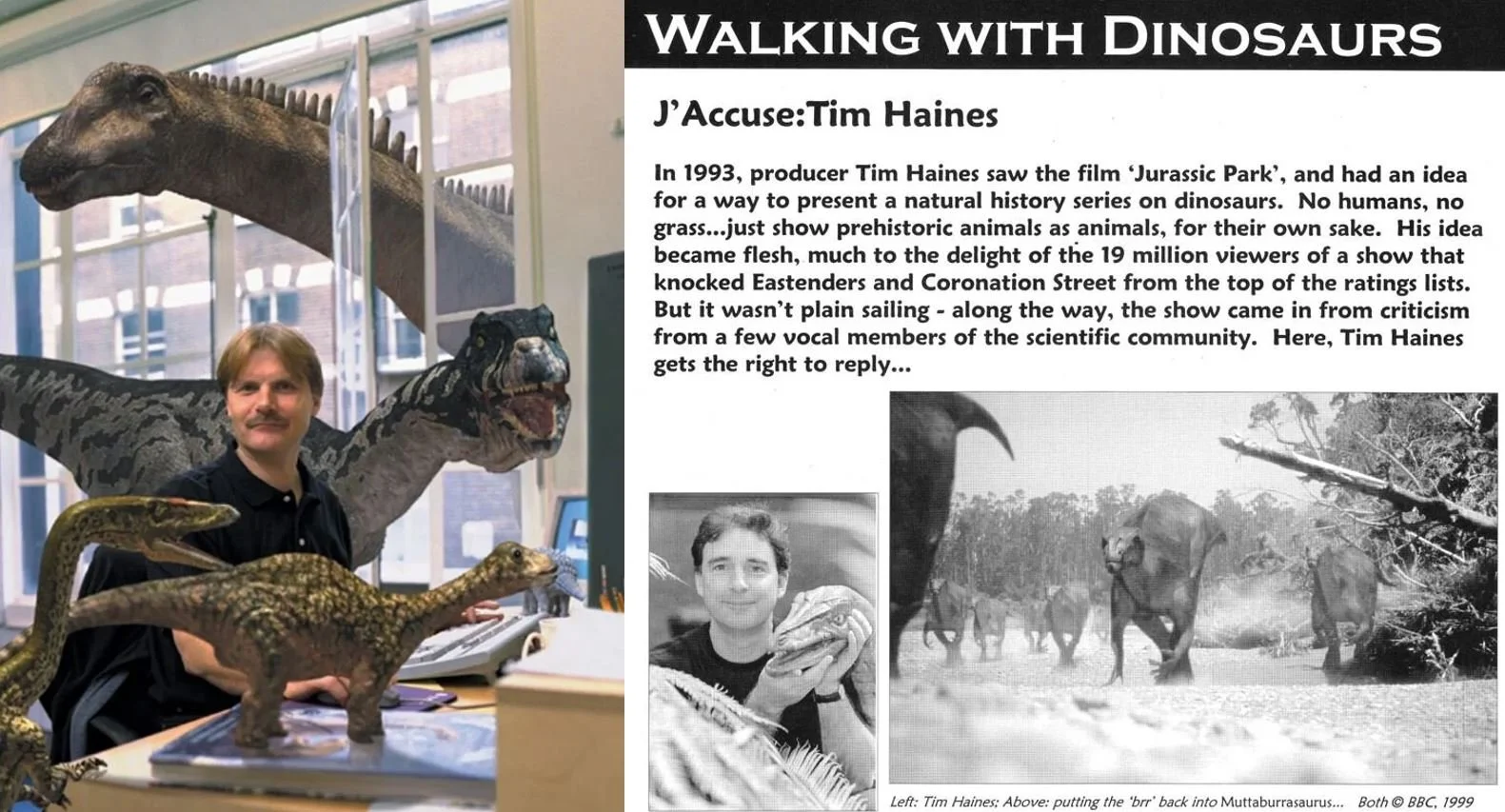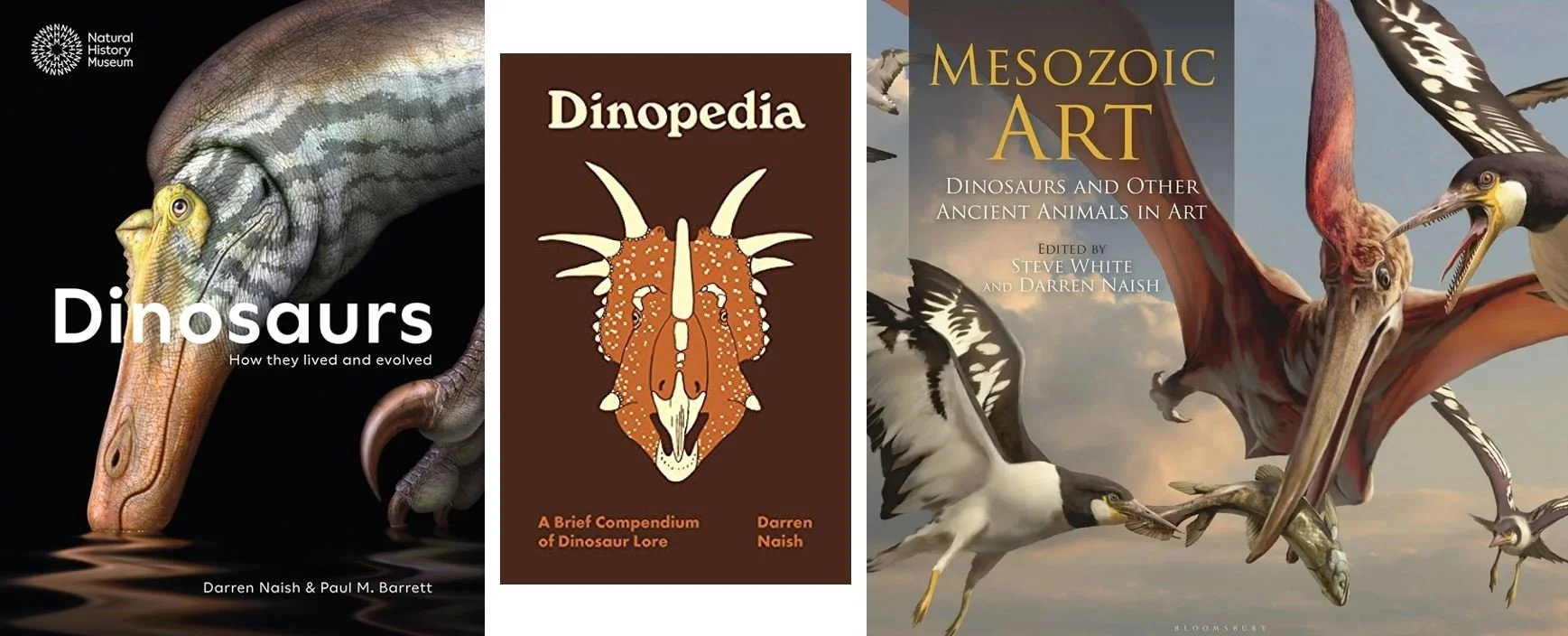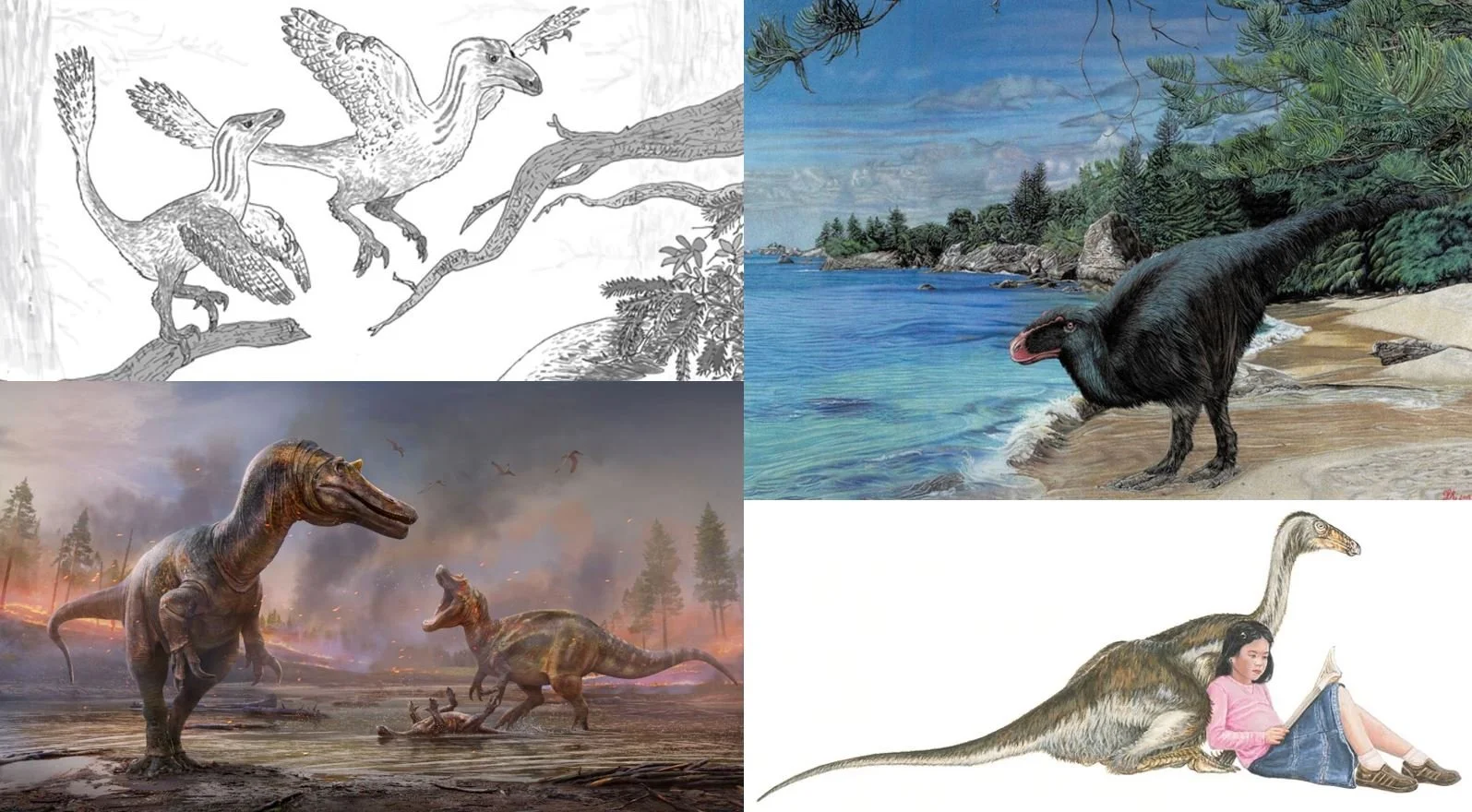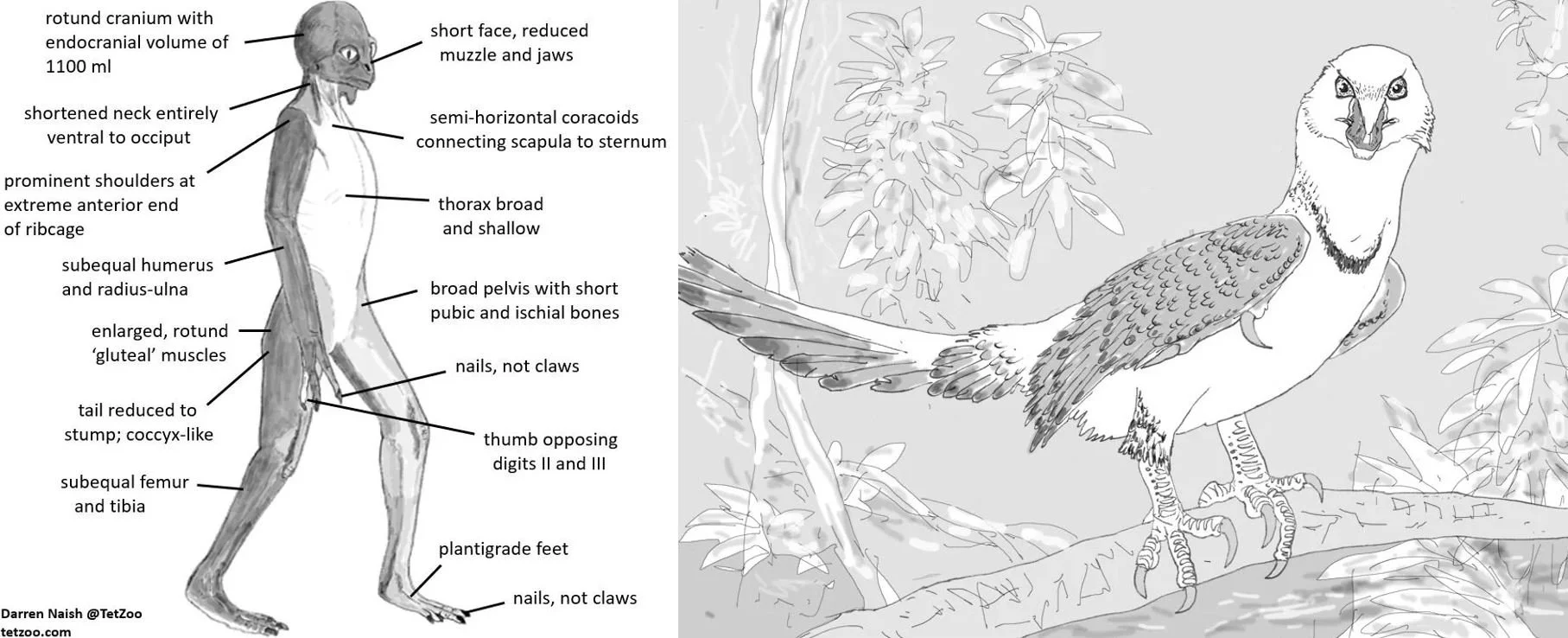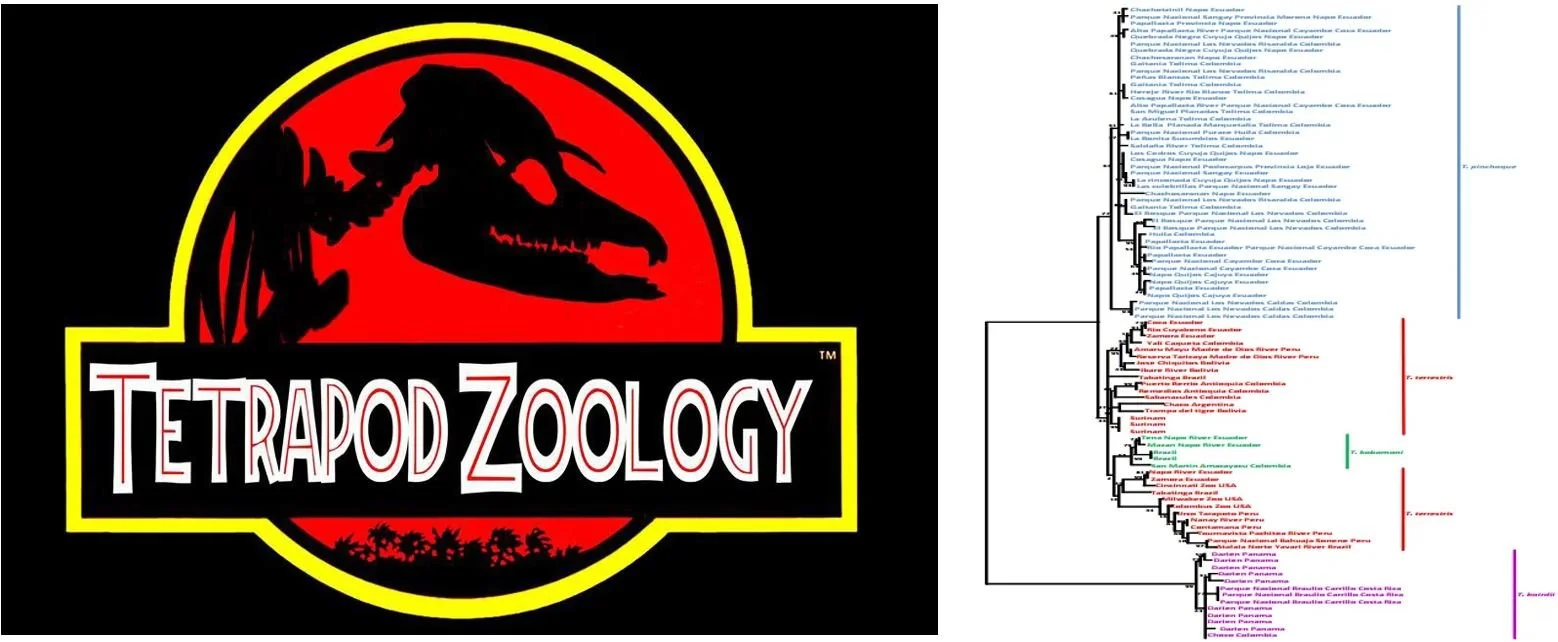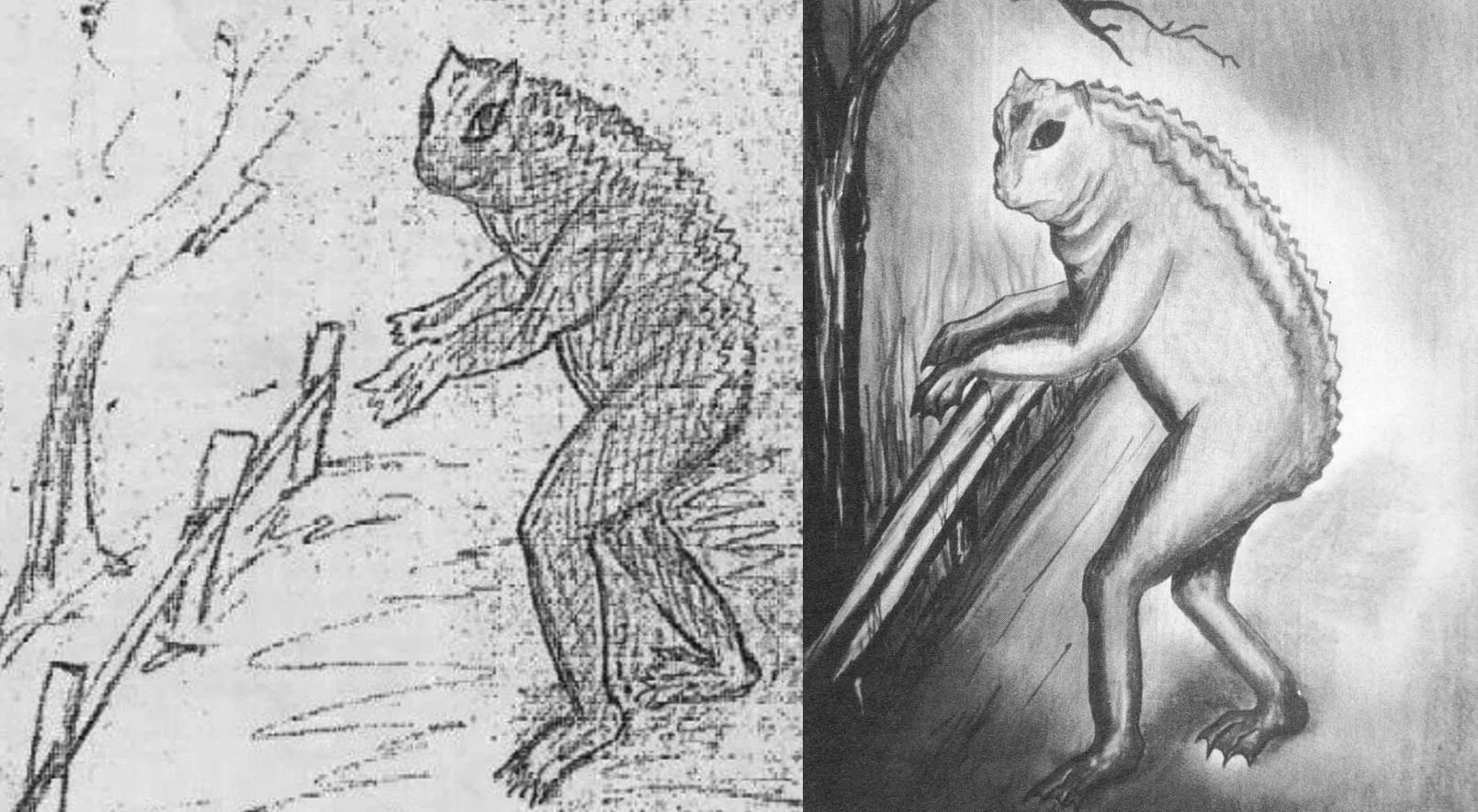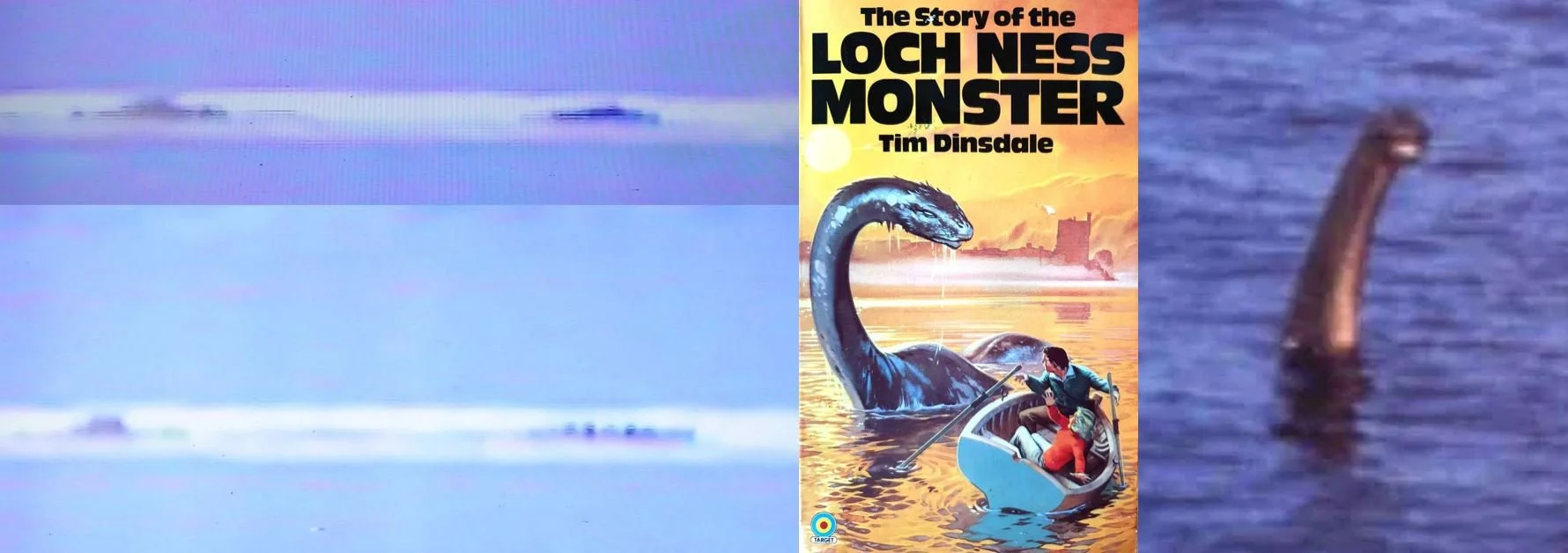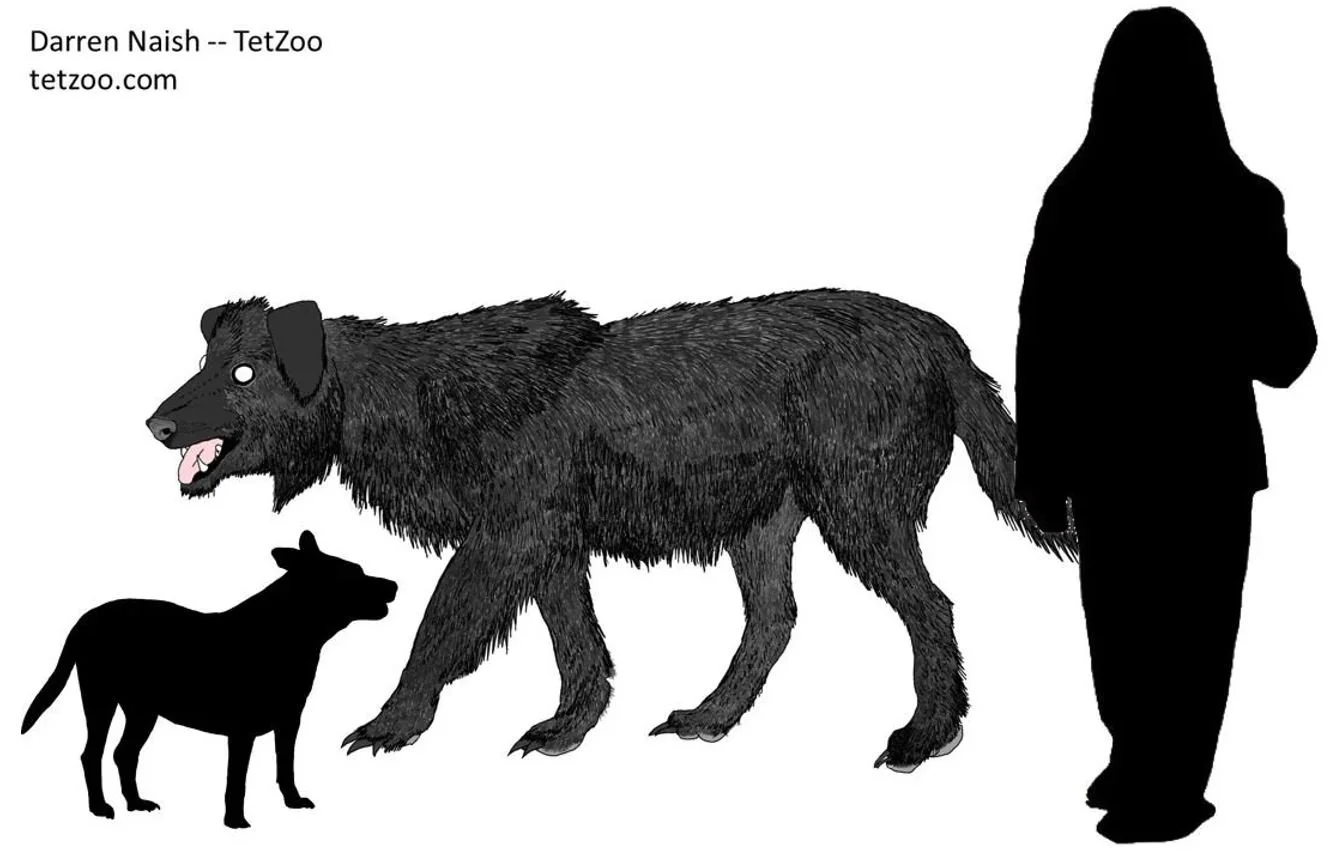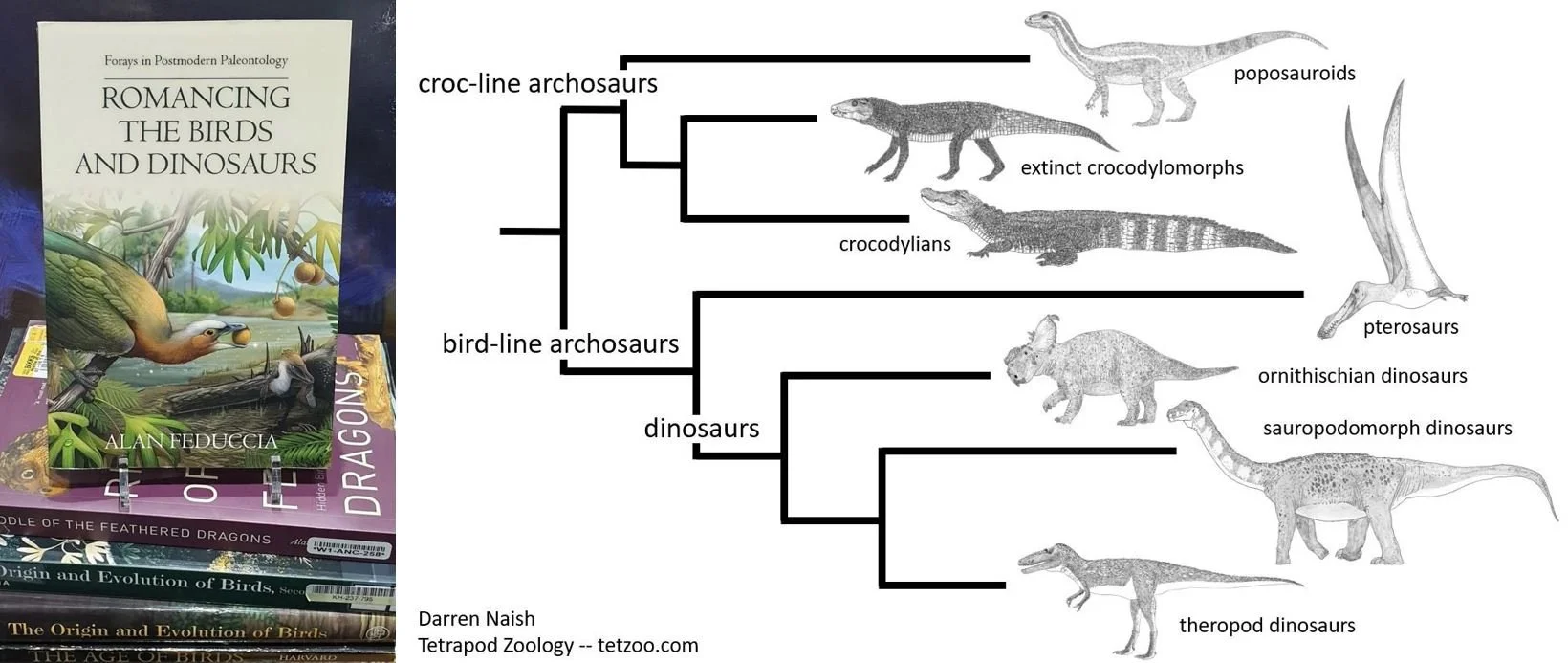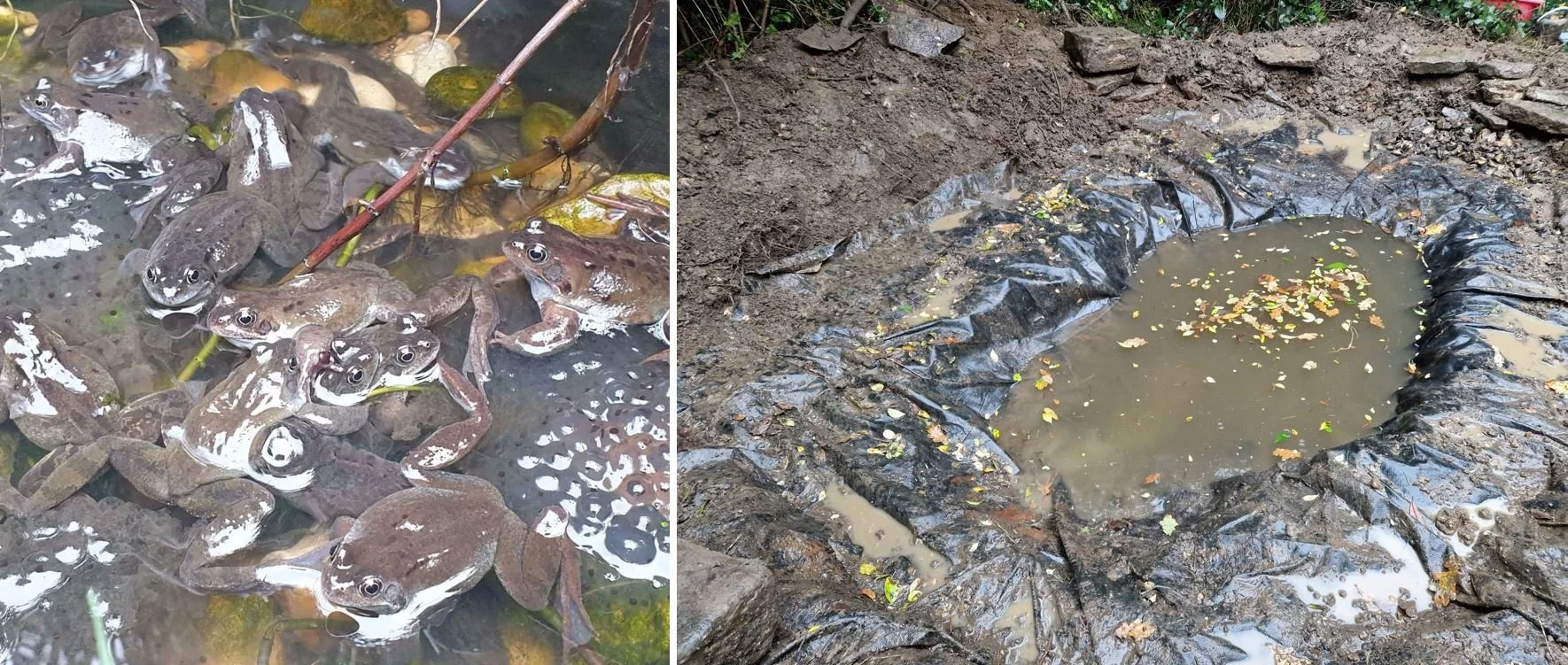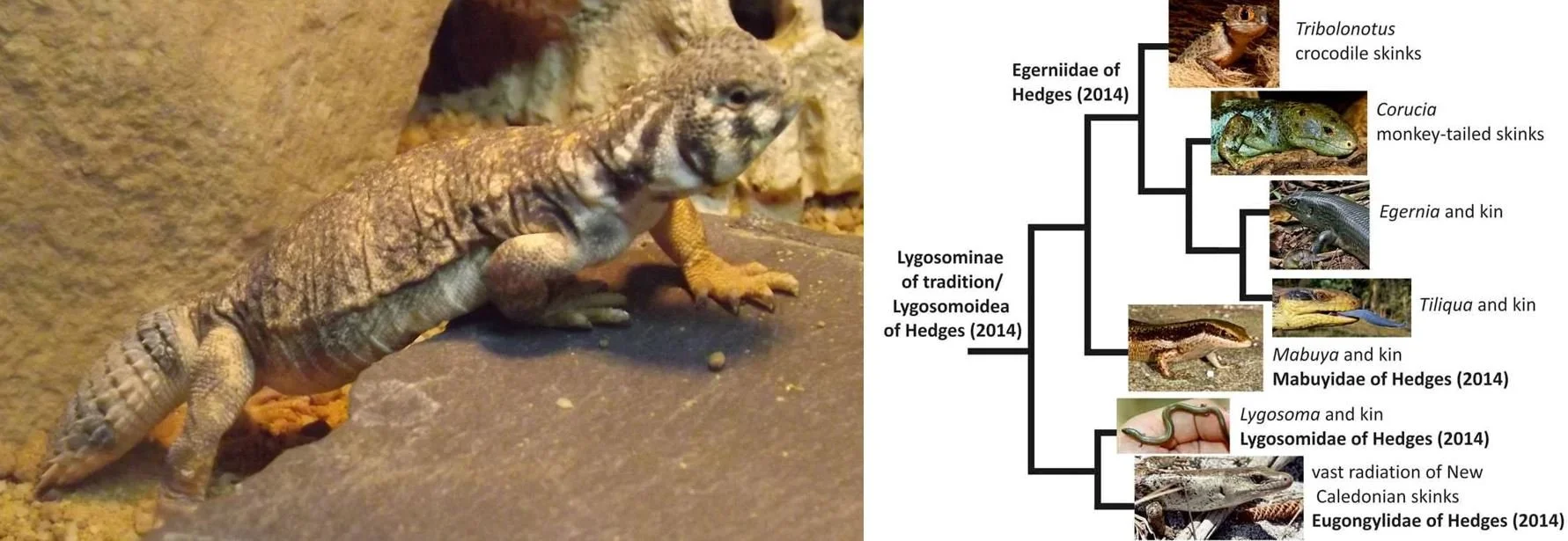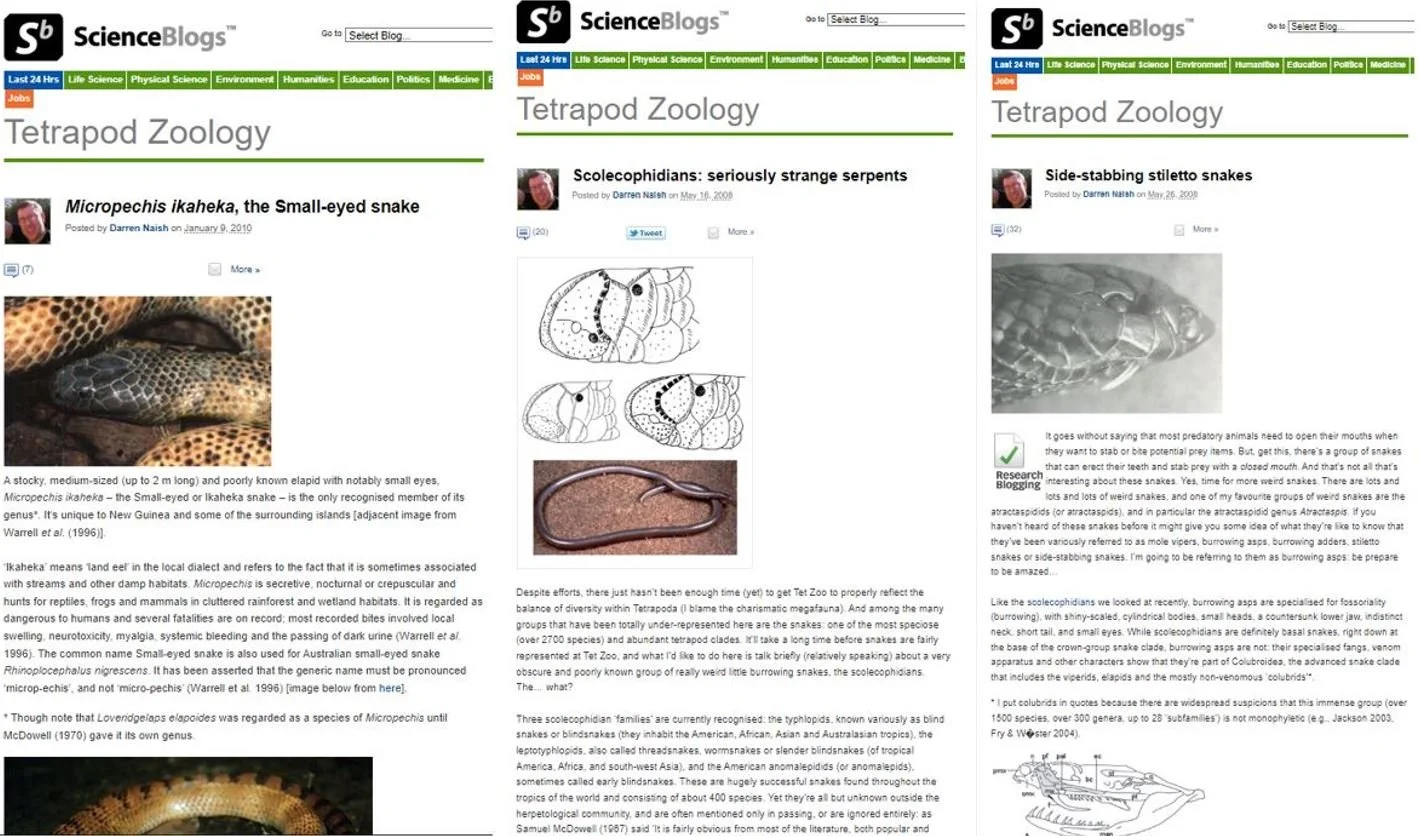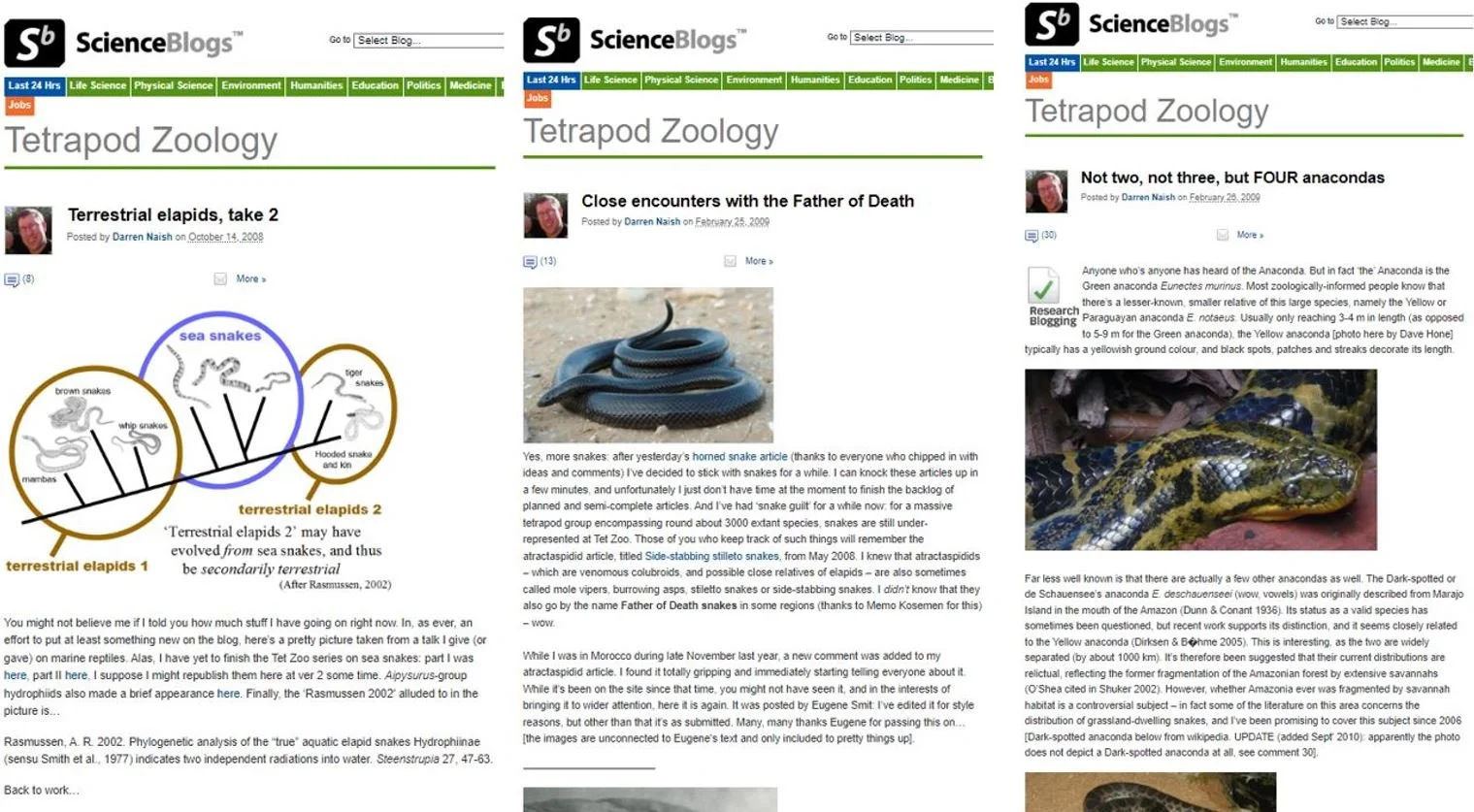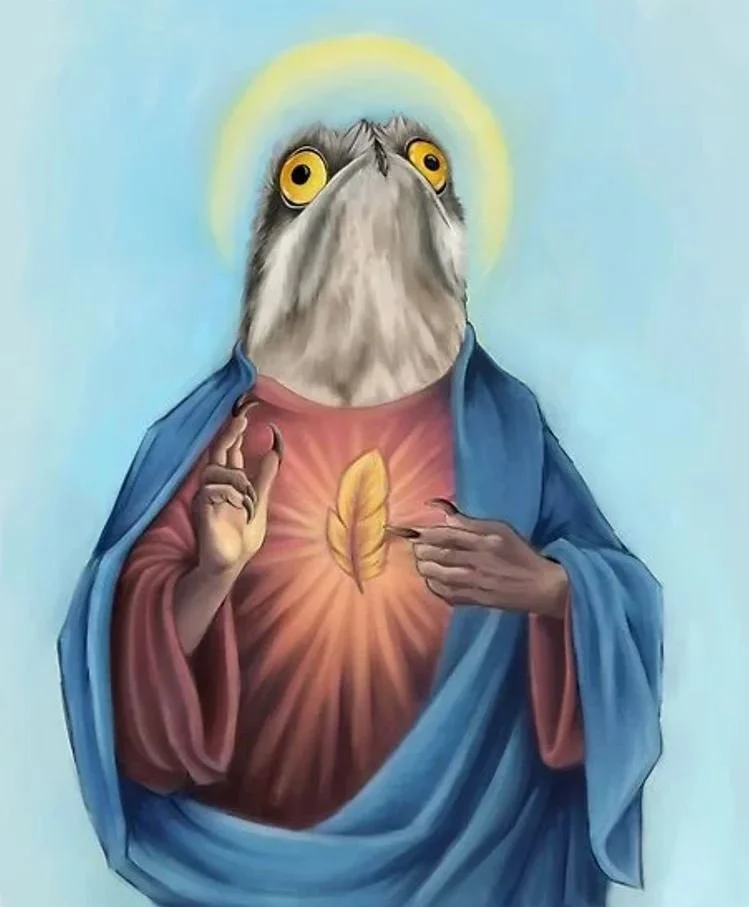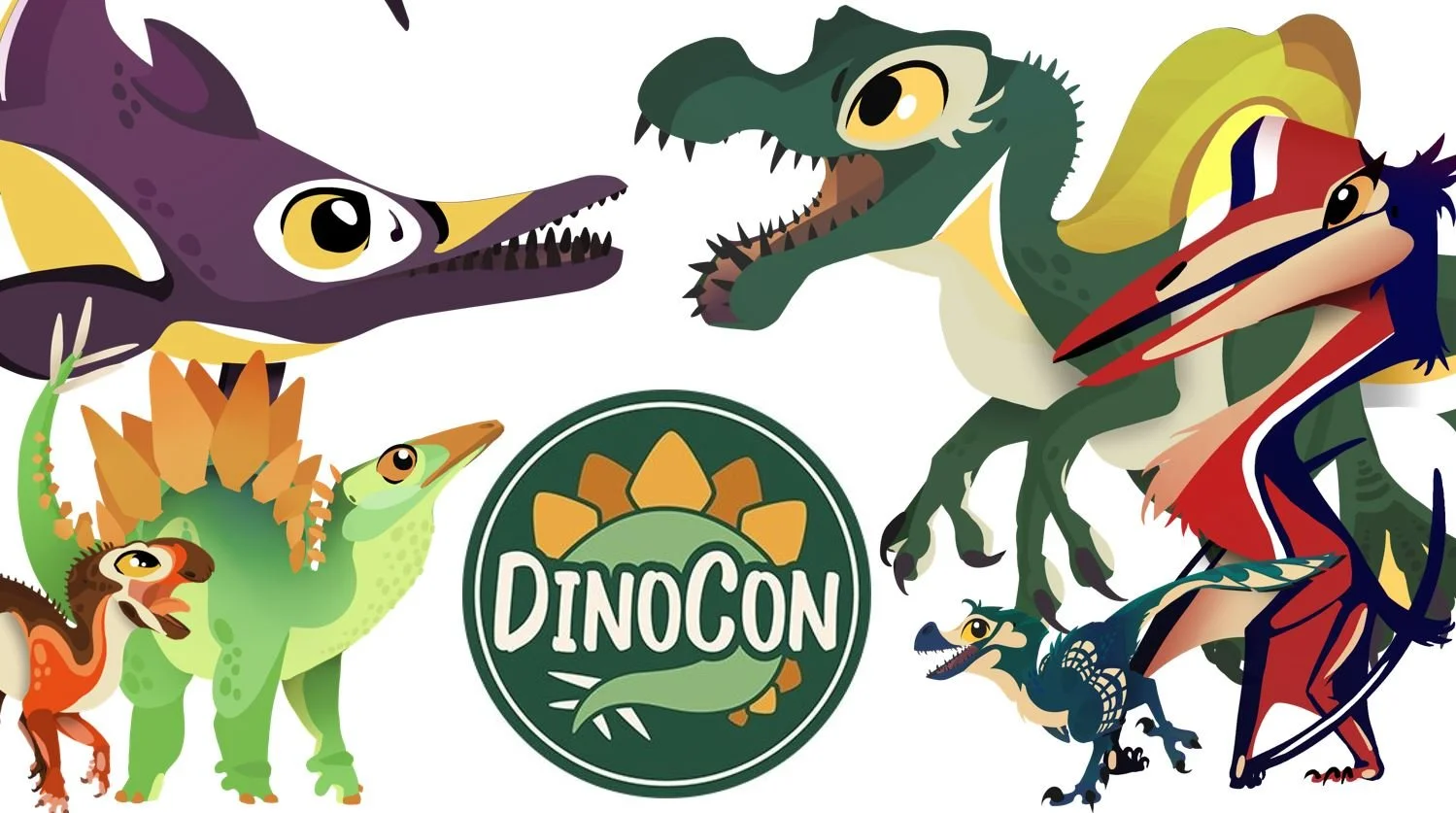Today is July 31st 2025… do you know what this means?
Caption: a montage of things somehow relevant to the history of Tet Zoo ver 4. From left to right: the 2022 publication of Ancient Sea Reptiles is deeply relevant to the history of this blog (it saw release as a second edition in 2023); my interest in cassowaries led to field collaboration with Todd Green in 2023 (that’s not Todd in the photo, but Liberace the red-necked northern cassowary); finally, the tenure of Tet Zoo ver 4 overlapped with the final days of Dinosaurs in the Wild, a travelling exhibition connected to various things that happened before and since. Images: Darren Naish.
It means, dear reader, that Tetrapod Zoology ver 4 – the version of the blog you’re consulting right now – began life on this very day, all but seven years ago, in 2018. And thus: happy 7th birthday Tet Zoo ver 4!
As a regular reader, you’ll know that Tet Zoo’s proper official birthday is on January 21st, and the next of those is a big one, marking 20 YEARS OF TETRAPOD ZOOLOGY. I feel like I should mark that event specially in some way, but quite how is not yet clear. Maybe a special line of merch should be released or something like that. The ver 4 birthday isn’t such a big deal, but it’s still one worth marking, and thus here we are.
Caption: TetZooCon – the annual Tetrapod Zoology Convention – has been a mainstay throughout the duration of Tet Zoo ver 4. The 5th and 6th of those events happened in 2018 and 2019, respectively, but a global pandemic meant that we switched to zoom-based versions in 2020 and 2021. The 9th event (2022) was in-person again, and things were back to normal for the 10th (2023) and 11th (2024). And that 2024 TetZooCon was the last one ever. Thanks to those who made it what it was.
The usual backstory stuff. As explained in the very first ver 4 article from July 2018, ver 4 started life as I packed my bags and said goodbye to Scientific American’s so-called blogging network in order to set up home here, a web location already created thanks to the podcast that John Conway and I record on an intermittent basis. Yes, the podcast is still a viable enterprise, it’s just that John and I have wholly incompatible schedules. We have had for years now.
Caption: John Conway and I have been working closely together for what feels like an eternity at this point. We talk about palaeoart a lot; at left, John is pondering different versions of a Greg Paul illustration. The podcast back-catalogue is here. John insists on wearing sunglasses indoors, that’s how cool he is (kidding, he actually doesn’t). Images: Darren Naish.
Here’s your reminder that the podcast back catalogue is here; many of the episodes are trainwreck garbage but at least some are good listening. My favourite is ep 72, the Loch Ness Monster special. I thank the people who say kind words about the whole podcast endeavour; it’s really appreciated.
Blog content, some thoughts. Anyway, the podcast aside, the blog itself has gone from strength to strength and there’s now a good amount of content covering most of the major tetrapod-themed topics I’m interested in or qualified to write about. There is, as ever, so much more to do, and I’m forever driven furious by the fact that I just can’t make time to write and publish more than I do already. Support me at Patreon dammit.
Caption: a good chunk of my time over the years since 2016 has been taken up by the making of TV shows that have a sort of connection to the seminal Walking With Dinosaurs of 1999. Partly for that reason, I thought it appropriate to publish my thoughts on that series: check out Part 1 and Part 2, both published in 2021. The image at left shows Mike Milne in an Impossible Picture office (RIP Mike; he died in 2024); the image at right is the intro from Haines (2000).
One of my aims is to rescue material from ver 2 (the ScienceBlogs years) and ver 3 (the Sci Am years) and re-publish it here at ver 4, since those respective hosters either no longer really exist, or (in the case of Sci Am) have ruined the material they host by removing its images or paywalling it, or both. You’ll know that I’ve rescued some material but there’s still so much more to get to. I also aim to have this older content published in book form, but that’s something I just can’t make time for either.
Massive, heartfelt thanks to the wonderful people who support me at patreon and assist in the perpetuation of this blog and the support of these planned publication projects. Please consider assisting me if you don’t already; there’s tons of unique, secret content there that’s never been shared anywhere else.
For the remainder of this article I want to bring attention to a hand-picked, annotated list of Tet Zoo ver 4 articles that I’m especially fond of, grouped together by subject. My aim in part is that you might be inspired to look at them again.
Caption: my workload has constantly thwarted my ability to publish as many books as I might like, but at least a few have seen release while ver 4 has been active. Among them are the third edition of Dinosaurs: How They Lived and Evolved (2023; with Paul Barrett), Dinopedia (2021) and Mesozoic Art (2022; with Steve White). Other books are currently in production or due to see print soon.
Mesozoic dinosaurs are a mainstay here at Tet Zoo and always have been, which is understandable both because I publish technical and popular research on these animals (my publications are here) and because they are – sorry other tetrapod groups – undeniably among the most awesome and fascinating animals of them all. Having said that, I’m still not sure whether I cover non-bird dinosaurs too much, or too little. Or do I cover them… just right? Among my favourite ver 4 articles are…
Could We Domesticate (Non-Bird) Dinosaurs?, August 2018
Recollections of Dinosaurs Past and Present, the 1980s Exhibition, February 2019
Two New Spinosaurid Dinosaurs from the English Cretaceous, September 2021
Robert Plot’s Lost Dinosaur Bone, December 2022
Post-Truthism, Brian J Ford’s Aquatic Dinosaurs, and the Fate of ‘Too Big To Walk’, November 2024
My Weird 2000 Paper on Tree-Climbing Dinosaurs, December 2024
Heptasteornis, My Beloved; Alvarezsaurids in Europe, the Backstory, January 2025
Caption: this was intended as a dinosaur-themed montage, but it says a lot that it’s ended up as, specifically, a theropod-themed one. Clockwise from top left: tree-climbing juvenile dromaeosaurids, from here; Eotyrannus in life, by Loana Riboli (copyright, used with permission), from here; a friendly ornithomimid with its human companion, by Mike Skrepnick (used with permission), from here; and British baryonychine spinosaurids new to science as of 2021, by Anthony Hutchings, from here.
Speculative Zoology – SpecZoo – is another topic that’s always been a Tet Zoo mainstay. My approach to this subject has been piecemeal so far, largely taking the approach of looking at one book or one idea, even, at a time. There’s call for big, synthetic articles that combine and contrast the writings of various contributors. Regular readers of Tet Zoo will know my argument (albeit not original to me) that SpecZoo has significant overlap with cryptozoology, a matter I aim to explore later this year in an academic manuscript.
The Dougal Dixon After Man Event of September 2018, September 2018
Dougal Dixon’s After Man, the Initial Pitch Document, June 2020
Humanoid Dinosaurs Revisited Again: Russell and Séguin’s Dinosauroid at (Nearly) 40 Years Old, August 2021
The Snouters or Rhinogradentians, a Brief Review, October 2021
Alternative Timeline Dinosaurs, the View From 2019 (Part 1), November 2019
Alternative Timeline Dinosaurs, the View From 2019 (Part 2), December 2019
Alternative Timeline Dinosaurs, the View From 2019 (Part 3): the Dinosauroid and its Chums, December 2019
Speculative Zoology and the World of After Man; an Interview With Dougal Dixon, April 2025
Speculative Zoology Grand and Photoreal: Boulay and Steyer's Demain, les Animaux du Futur, April 2025
Caption: ‘dinosauroids’ of two very different sorts. At left, the Russell-Séguin version (as illustrated for my 2021 book Dinopedia), a humanoid invented to show the inevitability of the humanoid form (see the full article here). At right, a more ‘realistic’ dinosauroid (in my view, of course): a smart maniraptoran theropod that kills mammals for a living. Images: Darren Naish.
Megamammals. I’m more of a reptile guy than a mammal one but I really do like mammals too, and among those I keep coming back to are the big ‘ungulates’, both of the land and of the water. Perissodactyls have had a fair bit of coverage here (and more is set to come), artiodactyls too… and that includes whales, which are artiodactyls: down with the pointless and redundant ‘Cetartiodactyla’ (Prothero et al. 2021). Proboscideans are under-represented here, as are fossil megamammals.
Whatever Happened to the Kabomani Tapir?, October 2018
Extreme Cetaceans, Part 1, September 2019
Kogia, Shark-Mouthed Horror, March 2022
The Domes of Wisdom: an Asian Elephant Tale, August 2022
The Slightly Surprising Diversity of Zebras, Part 1, October 2022
The Discovery of the Okapi, Part 1, April 2023
The Discovery of the Okapi, Part 2, April 2023
The Slightly Surprising Diversity of Zebras, Part 2, July 2023
Caption: come on, who doesn’t love tapirs? Tapirs have been mentioned or discussed so many times within the TetZooniverse that they might be unofficial emblems of the whole enterprise, as implied in this illustration (left) by Patrick Murphy. At right, this cladogram (from Ruiz-García et al.’s (2015) study of South American tapirs) shows how Kabomani tapirs (green) appear to be a lineage within Tapirus terrestris (red). For more, see the 2018 Kabomani tapir article here.
Cryptozoology. I’m a sceptic and emphatically not (at this point in my life) a ‘believer’ when it comes to Bigfoot, Nessie, sea monsters, living thylacines and so on (Naish 2017). But what seems to confuddle some people beyond all measure – yes, I do have a specific Wikipedia editor in mind here – is my belief that cryptozoological claims, data and hypotheses should be evaluated fairly in case they represent descriptions of real observations or encounters, not rejected out of hand. There’s been a fair bit of content here that approaches the subject in that way, but… let’s face it: it’s also really interesting to write about the beliefs and pet (sometimes wayward) hypothesis of cryptozoological authors.
Caption: cryptozoology includes the classic famous cryptids – Bigfoot, Nessie and the like – but what about the fringe creatures at the edges? Among my favourite is the Loveland frog of the 1950s and 70s, a creature I covered here in 2020. Images: alleged original eyewitness sketch, and a later redrawing by Ron Schaffner.
The 1972 Loch Ness Monster Flipper Photos, August 2020
The Case of the Cadborosaurus Carcass: a Review, November 2020
The Lake Dakataua ‘Migo’ Lake Monster Footage of 1994, February 2021
eDNA, Footprints and the Biological Bigfoot: Comments on an Interview With Jeff Meldrum, April 2021
Legend of the Black Dog, August 2022
Werewolves in America; the Tale of Dogman, July 2024
Caption: water monsters are great value for money, and doubly fascinating because many (albeit not all) of the accounts do involve real sightings of real animals. At left, stills from the Migo footage of 1994, covered here. Middle: it sure would be nice if Nessie sightings like this actually occurred, but they really didn’t. This book is by Tim Dinsdale, and for more on him go here. At far right, the Shiels Nessie, which I’ve written about at length but not necessarily here at Tet Zoo.
Caption: recalling what I said above the Loveland frog, are semi-mythical creatures like the Black dog (a special kind of phantom, not just a dog that’s black) relevant to conventional zoology? Well, I’m sufficiently interested in them that I have written about them (go here).
Debates in bird evolution. I have a vested interest in what we politely term non-standard hypotheses, and birds – for whatever reason – are afflicted by these. You can’t work on Mesozoic dinosaur or fossil birds and be unaware of the ‘Birds Are Not Dinosaurs’ (BAND) crowd, and – for my sins – I’ve covered that topic more than once. But birds of more modern sort (the neornithines) have an association with non-standard hypotheses too, and what’s interesting and telling is that the people who promote these are… the exact same set of contrarian nay-sayers, the BAND guys…
Caption: Alan Feduccia has had more than his fair share of time in the limelight, but his style of argumentation really needs to be called out for the contrarian pseudointellectualism that it is. At right, a rough consensus cladogram showing relationships within Archosauria. Feduccia argues in his latest book that we should abandon this (relatively) resolved tree and instead throw our arms in the air and embrace something more chaotic. Images: Darren Naish.
Frogs, salamanders, caecilians. I’m a massive amphibian nerd and have done what I can to give them fair credit here: there’s a ton of fascinating diversity in their biology and history, their conservation and global decline needs adequate coverage, and I’ve invested massively in assisting the lone species that occurs in the overbuilt, suburban bit of little England where I live. I haven’t covered amphibians enough, for sure, but there’s still some good stuff here…
A Love Letter to the Common Frog, August 2020
Allodapanura, the Biggest Frog Group You’ve Never Heard Of (Part 1), October 2020
Tiny Frogs and Giant Spiders: Best of Friends, August 2022
The Remarkably Weird Skeletons of Frogs, September 2022
The Amazing Caecilians, October 2022
What, If Anything, Is A Strabomantid?, January 2024
Small Obscure African Toads; Toads Part 14, January 2024
Live Spawnwatch Action From Pond 2 at Tet Zoo Towers, February 2024
Caption: my efforts to help Common frogs Rana temporaria and create more, and better, ponds, have been regular points of discussion here. I’ve built (and helped manage) several ponds during ver 4’s duration but still need to write at length about pond construction and design. Images: Darren Naish.
Squamates. I mentioned earlier my hopes that I might be able to rescue old content from previous versions of the blog. But this is such a daunting task that I can only make progress if I stick to articles on a specific animal group. For that reason, I’ve been rescuing and republishing article on squamates. Here are some of my favourites (with some others that were published here at ver 4 for the first time).
Caption: squamates have had some amount of coverage here, but it’s still not enough. For whatever reason, iguanians are over-represented (probably because they’re among the squamates most frequently encountered in captivity here in the UK). At left, captive Omani spiny-tailed lizard or Thomas’s mastigure U. thomasi from this 2018 article. At right, a skink cladogram from this 2020 article.
Caption: a montage which helps show how many squamate-themed articles were published at Tet Zoo back in the olden times. Virtually all of these articles are now only findable at wayback machine, and even then not in intact version. I’ve been doing what I can to rehabilitate them here at ver 4.
Finally, I should add that there are a number of additional articles that I also regard as useful and worthy but which don’t fit into the above categories. We can regard them as random favourites. Among them is my article my take on the internet culture of the potoo (February 2019), that on the life appearance of the Dodo Raphus cucullatus (July 2020), a compilation of surprising and odd, animal-themed Palaeolithic rock art (July 2019), and my retrospective on the 2001 Dorling Kindersley book Encyclopedia of Dinosaurs and Prehistoric Life (January 2022). And I haven’t rounded up articles on several other topics that have been revisited here several times, among them Mesozoic marine reptiles, my birdwatching efforts, the Tet Zoo Reviews Zoos series, and my writings on azhdarchoids (and other pterosaurs).
Caption: ‘Our Lord and savior potoo bird’. This image is by dragongirl222, who does a whole range of potoo-themed merchandise at redbubble. Image: (c) dragongirl222.
And hello DinoCon. Ok, that’s where we’ll end. Thank you for joining me in this 7th birthday celebration; special thanks again to those who help support Tetrapod Zoology. The proper birthday – in which I review the activities and events of the year that’s passed (and, oh boy… 2025…) – will be a far lengthier, more complex article, but we have some way to go yet before that time comes.
As I write, I and others are of course busy getting ready for another major event in the Tetrapod Zoology calendar: the first ever DinoCon (go here for info and tickets), the descendant of TetZooCon, this year held at the University of Exeter (UK) on the weekend of August 16th and 17th. The gamble has paid off and DinoCon is set to be huge, way bigger than even the biggest TetZooCon. This basically means that DinoCon is already set to be a regular fixture and can only get bigger and better with time. Do come along if you’re not already planning to do so.
Caption: the promotional art for DinoCon (which will be available on merchandise) was created by Natalia Jagielska.
And that’s that. Thanks for joining me here… more coming soon! For previous Tet Zoo birthday articles, see…
Happy first birthday Tetrapod Zoology (part I), January 2007
Happy first birthday Tetrapod Zoology (part II), January 2007
Happy second birthday Tetrapod Zoology (part I), January 2008
Tetrapods of 2007 (happy birthday Tet Zoo part II), January 2008
Happy THIRD birthday Tet Zoo, January 2009
Tet Zoo = 4 years old today, January 2010
2009, a year of Tet Zooery, January 2010
Four years of Tet Zoo: to infinity... and beyond!, April 2010
It is with some dismay that I announce Tet Zoo's first hemi-decade, January 2011
Tet Zoo 5th birthday extravaganza, part II, January 2011
Happy Birthday Tetrapod Zoology: SIX YEARS of blogging, January 2012
Happy 6th Birthday, Tetrapod Zoology (part II), January 2012
Tetrapod Zoology enters its 8th year of operation, January 2013 (I cannot find any intact versions of this article, thanks SciAm)
Today marks NINE YEARS of Tetrapod Zoology, January 2015
Tetrapod Zoology 10th-Birthday Extravaganza, Part 1: 2015 in Review, January 2016
Tetrapod Zoology 10th Birthday Extravaganza, Part II: the Rest of 2015 Reviewed, January 2016
Tetrapod Zoology 10th-Birthday Extravaganza, Part 3: Tet Zoo's Tetrapod Treatment in 2015, January 2016
Today Is Tet Zoo's 11th Birthday, January 2017
The 12th Year of Tet Zoo, January 2018
The Tet Zoo 12th-Birthday Event, Part 2, January 2018
The Much Belated Final Part of the Tetrapod Zoology 12th Birthday Event, December 2018
Tetrapod Zoology Is A Teenager Now, January 2019
Tetrapod Zoology's 14th Year of Operation, 2019 in Review, January 2020
On Tetrapod Zoology’s 15th Birthday, the Year in Review, January 2021
Happy 16th Birthday, Tetrapod Zoology, February 2022
Four Years of Tetrapod Zoology ver 4, July 2022
The 17th Year of Tetrapod Zoology: 2022 in Review, January 2023
Five Years of Tetrapod Zoology ver 4, July 2023
Tetrapod Zoology Reaches 18 Years of Age, January 2024
It Was the 19th Year in the History of Tetrapod Zoology, January 2025
Refs - -
Haines, T. 2000. J’accuse: Tim Haines. The Dinosaur Society UK Quarterly Magazine 3 (4), 8-9.
Naish, D. 2017. Hunting Monsters. Arcturus Books, London.
Prothero, D. R., Domning, D., Fordyce, R. E., Foss, S., Janis, C., Lucas, S., Marriott, K. L., Metais, G., Naish, D., Padian, K., Rössner, G., Solounias, N., Spaulding, M., Stucky, R. M., Theodor, J. & Uhen, M. 2021. On the unnecessary and misleading taxon “Cetartiodactyla”. Journal of Mammalian Evolution 29, 93-97.
Ruiz-García, M., Castellanos, A., Agueda Bernal, L., Navas, D., Pinedo-Castro, M. & Mark Shostell, J. 2015. Mitochondrial gene diversity of the mega-herbivorous species of the genus Tapirus (Tapiridae, Perissodactyla) in South America and some insights on their genetic conservation, systematics and the Pleistocene influence on their genetic characteristics. Advances in Genetic Research 14, 1-51.


